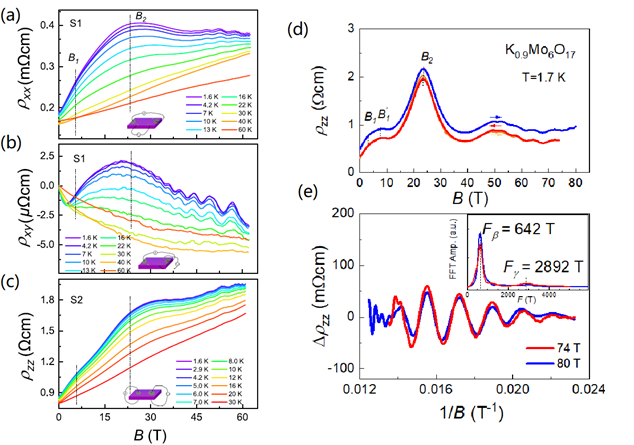
The high field transport properties of Na0.9Mo6O17(a-c)and K0.9Mo6O17(d-e).
(Phys. Rev. B 102, 235164; DOI: https://doi.org/10.1103/PhysRevB.102.235164 )
Background
The purple bronzes AMo6O17 with A=Na, and K are a family of typical low-dimensional materials with the presence of abundant properties related to the CDW state.The basic concept of CDW in this family is believed to be due to the presence of Peierls instability together with Fermi surface nesting.A metal-to-metal CDW transition occurs at TCDW=110 K in KMO and 85 K in NMO, respectively.The electronic structure in the normal state of KMO has been calculated by the tight-binding model, revealing the presence of three Fermi surfaces (FSs) (two electron FSs and one hole pocket) and confirmed by angle-resolved photoemission spectroscopy (ARPES). However,early FS topology studies of NMO revealed by the ARPES attained controversial conclusions on whether NMO has a similar FS structure with KMO. The magneto-transport study provides another approach to study the electronic structures by analyzing the Shubnikov–de Haas (SdH) oscillations and Hall effect. In this work, we study the SdH oscillations of NMO and KMO under high magnetic field up to 80 T to reveal the electronic structure of the two compounds.
What we discover?
We have systematically studied the magneto-transport properties ofNMO under magnetic field up to 62 T and KMO up to 80 T.Pronounced quantum SdH oscillations are observed inNMO and KMOunder high magnetic field. The FFT of the oscillations in NMO reveals three frequencies, with Fα=384 T and Fβ=574 T oscillations appear at around 35 T and Fγ=2779 T oscillations appear at 58 T. The angular dependence of the oscillations suggests the 2D origin of the Fermi surfaces related to these three frequencies. Meanwhile, the oscillations of KMO also show a frequency of Fβ=642 T up to 60 T. As the field is further increased to 80 T, fast oscillations of Fγ=2892 T has been observed. The slow frequency oscillations in both compounds can be related to the FSs in the field-induced CDW state, while the fast oscillations are attributed to the magnetic breakdown of the remaining FSs in the high-field CDW state.
Why is this important?
The major and unambiguous result of this study is depicted with the observation of 3 different quantum oscillations frequencies in NMO. The presence of multiple frequencies of the quantum oscillations can help us to understand the Fermi surface topology in the high-field CDW state. The most striking observation is the discovery of the Fγ oscillations in both compounds which can be attributed to the hexagonal part of the original FS, as a result of magnetic breakdown. The present work demonstrates the effect of magnetic field on the CDW state in the family of purple bronzes with hidden FS nesting.
Why did we need WHMFC?
The SdH oscillations in purple bronzes can be only accessible under magnetic field higher than 35 T. Fast oscillations Fγ appear at 58 T in NMO and at 70 T in KMO.In WHMFC, 62 T mono-coil magnet and 80 T dual-coil magnet were used for the transport studies in NMO and KMO.
Who did the research?
1. Wuhan National High Magnetic Field Center and School of Physics, Huazhong University of Science and Technology, 430074 Wuhan, China
H. P. Zhu, M. Yang ,*J. Z. Ke, H. K. Zuo, T. Peng, and J. F. Wang
2. Department of Applied Physics, Zhejiang University of Technology, Hangzhou 310023, China
Yi Liu and Xiaofeng Xu
3. The Institute for Solid State Physics (ISSP), University of Tokyo, Chiba 277-8581, Japan
Y. Kohama and K. Kindo
4. Department of Chemistry and Chemical Biology, Rutgers University, Piscataway, New Jersey 08854, USA
M. Greenblatt,
Acknowledgments
This work is supported by the National Key Research and Development Plan Project of China (Grant No. 2016YFA0401700), the National Natural Science Foundation of China (Grants No. 12004122, No. U1832214, No. 51821005, and No. U1732162) and the Fundamental Research Funds for the Central Universities (No. 2018KFYXKJC005 and No. 2019kfyXJJ009).
Link
https://journals.aps.org/prb/abstract/10.1103/PhysRevB.102.235164
